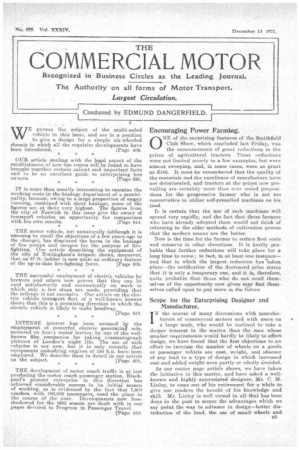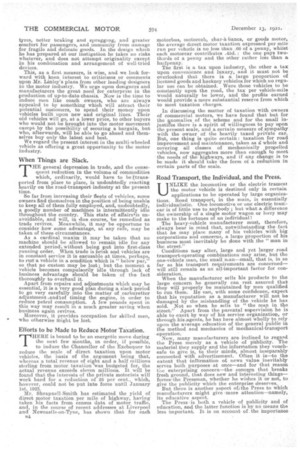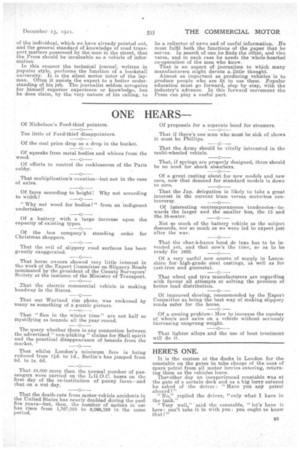Encouraging Power Farming.
Page 1

Page 2

Page 3

If you've noticed an error in this article please click here to report it so we can fix it.
ONE of the surprising features of the Smithfield Club Show, which concluded last Friday, was the announcement of great reductions. in the prices of agricultural tractors. These reductions were not limited merely to a, few examples, but were almost sweeping, and, in some cases, were as great as 2180. It must be remembered that the quality of the materials and the excellence of manufacture have not deteriorated, and tractors at the prices now prevailing are certainly more than ever sound propositions for the progressive farmer who is not too conservative to utilize self-propelled machines on his land.
It is certain that the use of such machines will spread very rapidly, and the fact that those farmers who have already adopted them would not think of returning to the older methods of cultivation proves that the modern means are the better.
Now is the time for the farmer to reduce first costs and conserve in other directions. It is hardly probable that further reductions will take place for a long time to come; in fact, in at least one instance— and that in which the largest reduction has "taken place—the notification of the decreased price states that it is only a temporary one, and it is, therefore, quite probable that those who do not. avail themselves of the opportunity now given may find themselves called upon to pay more in the future Scope for the Enterprising Designer and Manufacturer.
IN the course of many discussions with manufacturers of commercial motors and with users on a large scale, who would be inclined to take a deeper interest in the matter than the man whose smaller requirements would hardly be likely to affect design, we have found that the first objections to an effort to increase the number of wheels on a goods or passenger vehicle are cost, weight, and absence of any lead. to a type of design in which increased cost and added weight were partly or wholly avoided.
As our centre page article shows, we have taken the initiative in this matter, and have asked a wellknown and highly appreciated designer, Mr. C. M. Linley, to come out of his retirement for a while to give our readers the benefit of his knowledge and skill. Mr. Linley is well versed in all that has been done in the past to secure the advantages which we say point the way to advance in design—better distribution of the load, the use of small wheels and
tyres, better braking and spragging, and greater comfort for passengers, and immunity from damage for fragile and delicate goods. In the design which he has prepared at our instigation he takes no risks whatever, and does not attempt originality except in his combination and arrangement of well-tried devices.
This, as a first measure, is wise, and we look forward with keen interest to criticisms or comments upon Mr. Linley's plans from other leading designers in the motor industry. We urge upon designers and manufacturers the great need for enterprise in the production of up-to-date chassis. Now is the time to, induce men like coach owners, who are always appealed to by something which will attract their potential customers, to spend their money upon vehicles built upon new and original lines. Their old vehicles will go, at a lower price, to other buyers who would not be brought into the motor movement except by the possibility of securing a bargain, but who, afterwards, will be able to go ahead and themselves buy only the latest and best.
We regard the present interest in the multi-wheeled vehicle as offering a great opportunity to the motor industry.
When Things are Slack.
THE general depression in trade, and the consequent reduction in the volume of commodities
which, ordinarily, would have to be ?transported from place to place is undoubtedly reacting heavily on the road-transport industry at the present time.
So far from increasing their fleets of vehicles, some owners find themselves in the position of being unable to keep all of them fully employed, and, undoubtedly, a goodly number of machines is intermittently idle throughout the country. This state of affairslis un avoidable, and will, in due course, be remedied as trade revives. Meanwhile, it may be opportune to consider how some advantage, at any rate, may be taken of these circumstances.
Asa cardinal maxim it may be taken that no machine should be allowed to remain idle for any extended period,, without being put into first-class running order. When trade is brisk and vehicles are in constant service it is excusable at times, perhaps,
to run a vehicle in a condition which is "below par," so that no custom may be lost; but the moment a vehicle becomes compulsorily idle through lack of business advantage should be taken of the fact thoroughly to overhaul it.
Apart from repairs and adjustments which may be essential, it is a very good plan during a slack period to go very carefully into the matter of carburetter adjustment .andkof timing the engine, in order to reduce petrol consumption. A few pounds spent in this way may result in a much greater saving when business again revives. Moreover, it provides occupation for skilled men, who otherwise might be lost.
Efforts to be Made to Reduce Motor Taxation.
T'HERE is bound to be an energetic move during the next few months in order, if possible, to induce the Chancellor of the Exchequer to reduce the scale of direct taxation upon motor vehicles, the basis of the argument being that, whereas a total revenue of eight and a half millions sterling from motor taxation was budgeted for, the actual revenue exceeds eleven millions. It will be found that the interests of the private motorists will work hard for a reduction of 25 per cent., which, however, could not be put into force until January 1st, 1923.
Mr. Shrapnell-Smith has estimated the yield of direct motor taxation per mile of highway, having taken his facts from census data of motor traffic, and in the course of recent addresses at Liverpool and Newcastle-on-Tyne, has shown that for each
B4
motorbus, motorcab, char-abancs, or goods motor, the average direct motor taxation expressed per mile run per vehicle is no less than .66 of a penny, whilst each motorcar contributes .45d.: the one pays twothirds or a penny and the other rather less than a halfpenny. The first is a tax upon industry, the other a tax upon convenience and luxury, and it must not be overlooked that there is a large proportion of licensed goods and hackney vehicles for which no regular use can be obtained. Were those vehicles to be constantly upon the road, the tax per vehicle-mile would naturally be lower, and the profits earned would provide a more substantial reserve from which to meet taxation charges.
In discussing the matter of taxation with owners of commercial motors, we have found that but for the knornalies of the scheme and for the small injustitres there is a spirit of willingness to pay upon the present scale, and a certain measure of sympathy with the owner of the heavily taxed private car. But, one thing is quite certain : taxation for road improvement and maintenance, taken as a', whole and covering all classes of mechanically propelled vehicles, now aggregates more than enough to meet the needs of the highways, and if any change is to be made it should take the forum of a reduction in certain parts of the scale.
Road Transport, the Individual, and the Press.
UNLIKE the locomotive or the electric tramcai the motor vehicle is destined only in certain applications to be operated by large organizations. Bead transport, in the main, is essentially individualistic. One locomotive or one electric tramcar is of little use to anybody ; but what a difference the ownership of a single motor wagon or lorry may make to the fortunes of an individual !
The heavy-vehicle manufacturer must, therefore, always bear in mind that, notwithstanding the fact
that he may place many of his vehicles with big corporations and concerns, a large proportion of his business must inevitably be done with the "man in the street!' Conditions may alter, large and yet larger road transport-operating combinations may arise, but the one-vehicle man, the small man—small, that is, in so far as his transport requirements are concerned— will still remain as an 4-important factor for consideration. When the manufacturer sells his products to the large concern he generally can rest assured that they will properly be maintained by men qualified to run them. He can, with some confidence, expect that his reputation as a manufacturer will not be damaged -by the mishandling of the vehicle he has sold. Not so when he sells to "the man in the street?' Apart from the parental supervision he is able to-exert by way of his service organization, or through his gents, he has here almost wholly to rely upon the average education of the general public in the method and mechanics of mechanical-transport operation. Now, many manufacturers are inclined to regard the Press merely as a vehicle of piiblicity. The material they supply and the information they vouchsafe to give is, to their minds, almost inseparably connected with advertisement. Often it is—to the extent that inftirmation of. news value inevitably serves both purposesat once—and for that reason the enterprising concern—the concern that breaks fresh ground, that does new and interesting thingsforces-the Pressman, whether he wishes it or not, to give the publicity which the enterprise deserves. But there is another aspect oft he Press to which manufacturers might give -more attention—namely, its educative aspect. The Press -is both a vehicle of publicity and of education, and the latter function is by no means the less Unportant. It is on account of . the importance
of the individual, which we have already pointed out, and the general standard of knowledge of road transport matters possessed by the man in the street, thatthe Press should be invaluable as a vehicle of information.
• in this respect the technical journal, written in popular style, performs the function of a bookstall university. It is the silent motor tutor of the layman. Often it assists the expert to a better understanding of his job. The journalist seldom arrogates for himself superior experience or knowledge, but he does claim, by the very nature of his calling, to be a collector of news and of useful information. He must fulfil both the functions of the paper that he serves. In search of one -he finds the other, and vice versa, and M each case he needs the whole-hearted co-operation of the men who know.
That is an aspect of journalism to -which many manufacturers might devote alittle thought. Almost as important as 'producing vehicles 'is to produce people who are fit to use them. popular education must go forward, step by step, with the industry's advance. In this forwardmovement the Press can play a useful part.
































